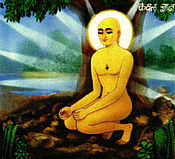- Mula Bandha
-
 Kevala Jñāna of Mahavira in mulabandhasana posture. Mula bandha has first literary mention in oldest Jain canon Acaranga Sutra
Kevala Jñāna of Mahavira in mulabandhasana posture. Mula bandha has first literary mention in oldest Jain canon Acaranga Sutra
Mūla Bandha is a Sanskrit (मूल बंध) compound term: Mūla denotes "root", "base",[1] "beginning", "foundation",[2] "origin or cause", "basis", "source";[3] Bandha denotes "bondage", "fetter",[4] "posture",[2] "joining together", "catching hold of".[5]
Iyengar (1976: p.525) defines Mūla Bandha as:
A posture where the body from the anus to the navel is contracted and lifted up and towards the spine.
This is qualified in that the actual muscle contracted is not the sphincter muscle nor the muscle which cessates urination, but the muscle equidistant between the two.
Maehle (2007: p.11) defines it as "root lock" and further specifies that:
The root referred to here is the root of the spine, the pelvic floor or, more precisely, the centre of the pelvic floor, the perineum. The perineum is the muscular body between the anus and the genitals. By slightly contracting the pubo-coccygeal (PC) muscle, which goes from the pubic bone to the tail bone (coccyx), we create an energetic seal that locks prana into the body and so prevents it from leaking out at the base of the spine. Mula Bandha is said to move prana into the central channel, called sushumna, which is the subtle equivalent of the spine.[6]
Mūla Bandha is the principal, key and primary Bandha of the Yogic Traditions. Mūla Bandha is endemic to all safe, grounded workings of bodymind disciplines. This Bandha in and of itself conditions the Muladhara Chakra, simultaneously keening, rooting and engaging the systemic plethora of processes that constitute bodymind and with diligence resolving them in discipline and accord. Mūla Bandha should be held as a restraint only after kumbhaka, which in this instance is where the breath is expressed in its entirety and held outside the body.[7] Iyengar (1976: p.435) likens the functionality of the Bandha and especially Mūla Bandha to "safety-valves which should be kept shut during the practice of kumbhakas".
Iyengar (1976: p.437) specifies the energetic prāṇas of Vāyu engaged through Mūla Bandha as: "...Apāna Vāyu (the prāṇa in the lower abdomen), whose course is downwards, is made to flow up to unite with Prāna Vāyu, which has its seat within the region of the chest."
Iyengar (1976: p.437) cautions that:
Mūla Bandha should be attempted first in antara kumbhaka (retention after inhalation). The region of the lower abdomen between the navel and the anus is contracted towards the spine and pulled up to the diaphragm.
Iyengar (1976: p.437) states that: "While practicing Mūla Bandha, the yogi attempts to reach the true source or mūla of creation."
Notes
- ^ Iyengar, 1976: p.515
- ^ a b Iyengar, 1976: p.459
- ^ Iyengar, 1976: p.437
- ^ Iyengar, 1976: p.525
- ^ Iyengar, 1976: p.436
- ^ Maehle, Gregor (2007). Ashtanga Yoga: Practice and Philosophy (Paperback). New World Library. ISBN 1577316061 & ISBN 978-1577316060, p.11
- ^ Iyengar, 1976: p.435
References
- Maehle, Gregor (2007). Ashtanga Yoga: Practice and Philosophy (Paperback). New World Library. ISBN 1577316061 & ISBN 978-1577316060
- Iyengar, B. K. S. (1966, 1976). Light on Yoga (or the Yoga Dipika). Thorsons: An Imprint of Harper Collins Publishers, Hammersmith, London. ISBN 1 85538 166 4
Categories:- Hindu philosophical concepts
- Asanas
- Sanskrit words and phrases
Wikimedia Foundation. 2010.
